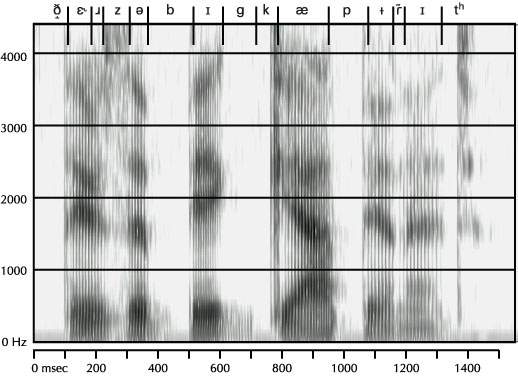
Depending on which font(s) you have installed, one or the other symbol in paragraph headings may not display correctly. To properly view the phonetic symbols on this page, you must have one of the following fonts installed on your system.

Eth,
IPA 131,
[D],
[ð]
Well, it looks like a plosive. There's a couple pulses of something that isn't quite
vowel-like right around 100 msec, and it ain't glottalization, so this is the clue that
there's an actually consonant at the beginning here. It can't be a nasal or an approximant,
unless the voicing just happens to click on for the 10-15 msecs that there's something
there, which I guess is possible, but unlikely. The edge of the vowel doesn't look like
a proper plosive burst, so that leaves some kind of fricative. At least underlyingly.
So it's probably a non-sibilant (and non-/h/) fricative. The good news is that the transitions
look alveolar, so if you thing this is a /d/, you're close.
Epsilon + Rhoticity Sign,
IPA 302 + 419,
[EÕ],
[ɛ˞]
The F3 drops linearly from the onset to the offset of this vowel, which is typical of /r/-colo(u)ring
before /r/. And you only really get r-colo(u)ring before /r/, so there must be an /r/ in here
somewhere. But I get ahead of myself. The F1 here is a little low, which would suggest this is
a mid-to-high vowel, but it probably isn't. It's very front, so given the /r/ colo(u)ring the
vowel must be /I/ or /E/. Okay, it looks like /I/. But oh well.
Turned R,
IPA 151,
[¨],
[ɹ]
So where's the F3 below 2000 Hz? In your dreams.
Lower-case Z,
IPA 133,
[z],
[z]
Well, it looks voiced. And it looks fricative. And it's strongest in the highest frequencies.
Schwa,
IPA 322,
[«],
[ə]
It's short. It's mid, vaguely central and pretty neutral F3-wise.
Lower-case B,
IPA 102,
[b],
[b]
This gap is preceded by some pretty significant downward-trending transitions, suggesting
bilabiality. The gap seems to last almost 150 msec, and the first half is voiced.
That's pretty long, and you might think that this is two phones. Well, think what you
want when you try to make a sentence out of this mess. So voiced and probably bilabial.
The release is definitely not aspirated, without a huge burst, and without a lot in the
way of specific transitions. So conservatively this is one big [b].
Small Capital I,
IPA 319,
[I],
[ɪ]
Well, if you compare the F1 of this vowel with the F1 of the prevous vowels, and wish
really really hard, it's just a little bit lower, so whatever those vowels were, this
one has to be higher. And way front.
Lower-case G,
IPA 110,
[g],
[g]
Another very long gap, the first half is voiced. The transitions in (and out) suggest
velar on both sides, so once again, you might think this is two phones. THis time y ou'd be
right, but I'm not sure how you'd tell the difference.
Lower-case K,
IPA 109,
[k],
[k]
The F2 F3 pinch in the transitions out suggest that this plosive (or these plosives) are
still velar. The multiple burst is also compatible with that hypothesis.
Ash,
IPA 325,
[Q],
[æ]
Okay, this looks like a diphthong, [ia] or something. Which it might be, but
that's not how I think I talk. The preceding velar is very front, in part due
to coarticulation or coproduction or whatever with the surrounding vowels. So the
vowel here starts front, and even though the F2 dives, it doesn't dive past
neutral. So from about 900 msec to the end of the vowel, F1 is very high and F2 is fairly
neutral, and both are pretty steady. So taking that as our cue, we've got a very low
vowel, that is vaguely central, which is pretty much where /ae/ is, so I take the rest
of it to be transitional.
Lower-case P,
IPA 101,
[p],
[p]
Another gap, but this one doesn't start terribly sharply. I have to wonder if that isn't
more typical of coda consonants than onset onces, but maybe I'm the only one. For its duration
it doesn't build up a lot of pressure to get released into the following vowel, so this is
either a really weak onset or a really long coda. But that's just me musing about
prosody. There's not a lot of transitional information I can take away and be sure of.
Compared to the previous longish gaps, the voicing in this one dies pretty quickly, so
this is probably voiceless, whatever it is.
Lower-case I,
IPA 301,
[i],
[i]
Well, this is another ambiguous F1. The F2 starts quite front, and drops into the
neutral range. The F2 tells us nothing. So I'd say schwa or /I/ or something, hence
barred-i.
Fish-hook R + Tilde
IPA 124 + 428,
[R)],
[ɾ̃]
Shortish gap, like a flap, but there's resonances in the formant regions. Which
makes this look like a nasal. Which would explain why the bandwidths of the F1 on
either side are so goofy.
Small Capital I,
IPA 319,
[I],
[ɪ]
So, no F1 information. F2 vaguely front, but not very. I probably should have transcribed
this as another barred-i, but I didn't. But now many VnVC sequences can you think of?
Lower-case T + Right Superscript H,
IPA 103,
[tH],
[tʰ]
Shortish gap, with a sharp, [s]-shaped release. So even though the transitions are not
telling us much, this really can only be a /t/.